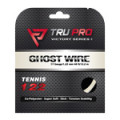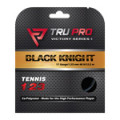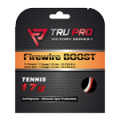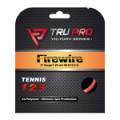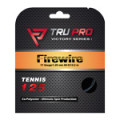
Photo: Chino Rocha/Unsplash
The simplest approach to winterizing your gear for playing outdoors in cooler temperatures is changing to a different string and playing with lower string tension.
Urbana - This winter, climatologists predicted an El Niño weather pattern for the Midwest. Usually means above-average temperatures and dryer, below-normal precipitation. The weather the last four days in Champaign-Urbana has turned cooler, wetter, and even windier than anticipated. Fortunately, daytime highs are supposed to return to the 50s and low 60s by this weekend, which is good news for many tennis players in Champaign-Urbana.

Photo: Jonas Vandermeiren/Unsplash
According to weather experts, winter shouldn't look this in Champaign-Urbana this season.
1. Level up by layering up
A long-sleeve dry-fit top, a t-shirt, and medium weight sweatshirt will probably keep the upper part of your body sufficiently warm when the air temperature is in the mid to upper 40s while playing. You can add or remove layers as suit your personal comfort needs. Shorts, coupled with either running pants or traditional sweatpants, should keep you warm enough for singles play. Add another layer by wearing Dry-Fit leggings under sweats or joggers. Don't forget to wear a hat. We lose 50% of our body heat from our head and neck region. Neck gaitors can be pretty effective in keeping your body feeling warm on a chilly day, too.2. Adjust your grip
When the temperature dips below the mid-40s (and for some of us below the mid-50s), you'll probably want to wear gloves. If you plan to play outdoors regularly in cooler temperatures, consider buying a second or third racquet and set it up - more on that later - exclusively for outdoor use. Depending on the gloves' thickness, consider removing the overgrip and/or grip so you can feel edge of the bevels on your racquet's handle. This will also keep you from having to grip the racquet tighter in order to maintain control of it. Between points and on changeovers, keep your hands warm by sticking your hands in your pockets. Tennis tends to be just as much a social activity as competitive. Warm up those fingers while chatting up you opponent or doubles partner. Another hack, this one borrowed from the NFL players who play in extremely-cold temperatures, is to rub hands and exposed skin with vaseline or a product called Warm Skin. "The idea [is] that it closes the pores a little bit and gives you a little bit more protection from the elements," is what Dr. Samuel Taylor, sports medicine surgeon at the Hospital for Special Surgery and associate team physician for the New York Giants, told AccuWeather reporter Ashley Williams.3. String it up right
Ambient temperatures affects the rubber in balls, racquet stiffness, and the way strings feel when hitting the ball. As the temperature drops, the rubber on the tennis balls and plastic strings become stiffer, resulting in a boardy feel on impact. Playing with old balls and polyester strings with tensions in 50s or higher in 40º temperatures might feel more like baseball or cricket. For a competitive outdoor match, start with a can of new balls for a better bounce. Extra heavy duty balls are an absolute must below 50º or so, regardless of the court surface, if your rely on kick serves to start your points. Depending on the frame and its composition, your racquet feedback - the way the ball feels and the shock transmitted on impact with the ball - may feel almost foriegn. The loss in flexibility may translate to a loss of power and pace with some strokes. Players who need more power from their sticks can add more mass in the form of lead tape, starting conservatively at first, to increase the depth and penetration on their shots.
Illustration by Charly Gutmann/Pixabay
4. Stay hydrated
A common misconception is you don't need to drink much water when it is cold out. That is further from the truth. Because cooler air is dryer, you won't notice the sweat as much and may not think you need to drink water. In reality, thanks to faster evaporation, additional layers of clothing, and increased water loss from breathing, you still need to plenty of fluids and electrolytes.
Image by Lars/Pixabay
Playing tennis in colder temperatures can help improve your overall game by giving you the opportunity to improve your game by playing tougher shots like drop shots and low-bouncing balls that skid across the court when it is colder. Winter tennis is a great way to improve footwork and anticipation skills for the next warm-weather season.
5. Change up your style of play
A lot of tennis players don't like cold-weather tennis because it is more physically challenging. Toward the end of October in central Illinois, the sun is lower on the south horizon, and there is always a light to steady breeze out of the northwest, making it more challenging to serve and track the ball during rallies. The cooler ambient air drops the air pressure inside balls and makes the rubber under the fuzz harder, making the ball bounce lower than usual. Strong players capable of grinding from the baseline for seemingly hours and use heavy topspin to push opponents back tend not to enjoy chasing low balls and skidders inside the service line. Net play coupled with drop shots, slices, and flat serves are the key to playing winning cold-weather tennis.Related articles:

CU is a great place for tennis; 5 really good reasons why you want play, too
If you love tennis, then Champaign-Urbana is a great community to live in. With over 120 courts available, two well-maintained indoor facilities, and plenty of options for lessons and instruction, tennis is a fun sport for all ages to stay physically active, mentally sharp, and compete as a recreational player anywhere from a local level all the to way various national championships.
See more...

Tigers tennis duos set to face first-round opponents today
There's nothing like competing against the best athletes in the state. Urbana's #1 and #2 doubles pairs will put their training and mental stamina put to the test when they take the court in Day 1 competition at the Illinois High School Association's Girls Tennis State Final.
Tigers Alisa Tangmunarunkit and Luna Morales play their opening match against...
See more...
Play better with Tru Pro Strings

